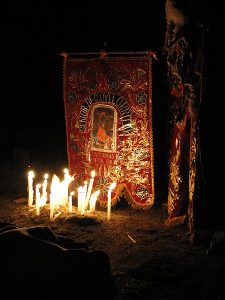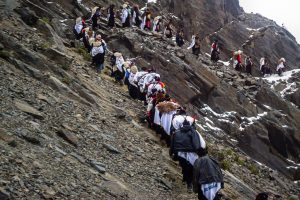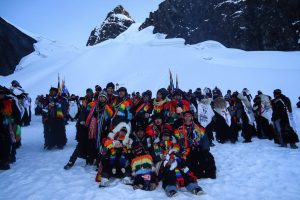The Passion of Qoyllur Rit’i Strikes Cuzco

After days of clouds and some rain, the enormous mountain Ausangate showed itself recently on the north end of Cuzco’s Huatanay Valley. White and blue, its glaciated peak stands out against both sky and ground as if somehow it were the combination of sky, blue, and clouds tied to ground.
For the people of Cuzco it is a great Lord, who they recognize and honor for its power and glory. Although Catholicism has claimed this land for five hundred years, or so, Apu Ausangate still stands out. Its glacier, in fact, will draw tens of thousands of pilgrims on Friday the 24th, from the city of Cuzco and communities in the state of Cuzco and nearby areas.
Officially the pilgrimage is to the Lord Jesus of Qoyllur Rit’i [koy-your-ree-tee]. As in many other places, Catholics placed a Holy Image on areas that attracted significant pre-Catholic devotion and then engaged in a war over meanings as they tried to eradicate the former and impose the Christian. They have painted an image of Christ on a rock by the glacier.

People go to make petitions and prayers to the Christ tied to the living rock of the mountain Ausangate, right at the retreating foot of its massive snow field. Though retreating due to global warming like all tropical glaciers, the glacier on Ausangate continues to draw people. The name of the pilgrimage comes from rit’i meaning snow, and qoyllur meaning star. Evidently, the star refers to the reappearance of the Pleiades in the Southern sky at this time.
In Cuzco, people are talking about Qoyllur Rit’i and asking each other if they are going. But they also caution that if you think about it and want to go, you must go or you will suffer all kinds of problems. With this warning you can see how intensely the snowfield on Ausangate, with its figure of Christ, pulls on the people of Cuzco at this time.

Six days after the main celebration on the mountain, the City of Cuzco will break into one of its central feasts, one that also maintains a continuity with the great Inca Inti Raymi feast, Corpus Christi. The city’s saints will process through the city, claiming its neighborhoods and people both in their majesty and in all the social and ritual activity they demand. It is as if the entire city were drawn in.
People feel the pull of the mountain to take them out of the city and up to very high altitude, beyond the level of human habitation, where the snow resides. They talk about it and remember the last time they went.

They leave Friday in the light of day in order to arrive at the trail head under the light of a full moon. They climb up towards the gleaming light on top of the mountain, the snow star, chewing coca to make the hike easier.
When they arrive, near dawn, they attend mass in the rustic chapel of the Christ, rent space in tents to rest for a bit, or sit, drinking something hot while waiting for daylight.
The mountain peak and its snow field are the first to receive the blessing of the rays of the morning sun. The God of the Incas and a Roman God is attached inevitably with Christ. This is a powerful moment.
People come in costume as part of troupes, called nations. These nations dance in the ancient way. They make movements that shift like the winds, communicating their desire to bring fertility and blessings to their people and communities.
Others set out and play. This word, play, which in the West smacks of childhood and leisure, has lost its sense of holiness that was understood in ancient times, including those of the Inca. While solemnity may fill Basilicas and Cathedrals, here people laugh and play, eat and drink. In all of this they test their luck.
They come with petitions, prayers in their heart. Often they hope for a house, a car, a shop, a truck. They want money and health. School sometimes is on their mind with its grades and diplomas; travel with its passports can be another wish.
Some people’s desires are like an open wish, a raw prayer. As they play they look to see whether fortune will come their way to enable them to fill that need or if they can do something to attract luck or make it.

To this end people will obtain miniatures, small representations of the things they wish for. They will take care of these miniatures throughout the year, feeding them, caring for them. This is all part of what in Aymara is called alasitas, the feast of miniatures and of buying and selling. The small items are seeds that, if cultivated, will lead to you obtaining that which you desire.
People say that you must undertake the pilgrimage three years running to obtain the object of your desires. They affirm this works.
The theme of hope and solution joins the various threads of Qoyllur Rit’i, for the Catholic Church Christ stands as the gate to salvation. For historical, agricultural peoples, this is the time of harvest. The harvest contains worries about guaranteeing it and keeping it safe from pests, all the while preparing the earth for a good production once the rains come again. For the people of the towns and cities, it responds to the question of social success and the mystery of obtaining productive consumer goods. As a result, it is not surprising that an indigenous name for the area of the shrine is Qullqipunku, that is the gate to what is desired. Qullqi is generally translated as silver, and is often used to refer to money, but its root seems more to have to do with hope and solution, and perhaps abundance.
As the day nears its end, people begin to walk down the trail, to find a truck or bus for their return to Cuzco. There they will tell their friends and family over and over about their experiences and carefully watch for the fulfillment of their desires. The conversations continue, building excitement for the next year.




